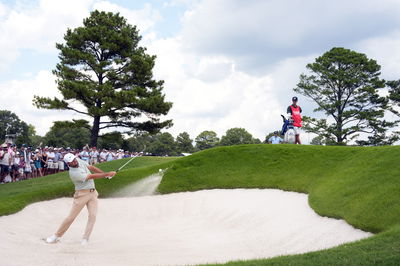Ten of the Best: Golden rules of golf
If you're confused by the sheer number of golf rules then check out the most important top ten

In the complex game of golf there are so many different situations and incidents occurring on a daily basis that you wouldn't even think of giving a rule to, but they all need to be written down somewhere.
Incredibly, the official interpretation of the rules has 34 main sections, 2000 explanatory sub-sections, and runs over a 582 page document, with the addition of 132 pages of indexing. Enough to make your brain fry.
In this article we've outlined the ten most common rules you're likely to come across during a round of golf, taking the results from the USGA and GOLF Magazine's collaboration of 1982, with the current update undertaken by Links Magazine in partnership with the USGA.
1. Play the ball as it lies
Play the ball as it lies. Wherever the ball ends up, whether it's in a divot (see right) or in a deep bit of rough, you still have to play it at the point it came to rest.
2. You may lift objects not fixed or growing
Don’t move, bend, or break anything growing or fixed, except in fairly taking your stance or swing. Don’t press anything down. Even if you're in a bush with branches all around you (see right), you can't affect any of it before your stroke.
3. You may lift natural objects
You may lift natural objects not fixed or growing, except in a water hazard or bunker. No penalty. Leaves on the green are allowed to be moved (see right).
4. Movable man-made objects may be moved
Movable man-made objects may be moved. For immovable objects, you may take relief by dropping away from them within one club-length of the nearest point of relief, no nearer the hole, except in a water hazard or if the object defines out of bounds. In a bunker, you must drop in the bunker. No penalty. Cables are man made objects that can be moved (see right).
5. You may take relief from...
You may take relief from casual water, ground under repair, burrowing animal holes or casts, anywhere except in a water hazard. On the putting green, place at the nearest point of relief, no nearer the hole; otherwise drop within one club-length of the nearest point of relief, no nearer the hole. In a bunker, you must drop in the bunker. No penalty.
6. Don't touch hazard or bunker with your hand or club
In a water hazard or bunker, don’t touch the water or ground with your hand or club before the stroke. Always have the club head hovering around the ball's equator (see right).
7. Dropping the ball after going in a water hazard
If you hit your ball into a water hazard and cannot find or play it, either drop behind the point where the ball last crossed the hazard margin or at the place where you played the shot. On the tee, you may tee the ball. One penalty stroke. If you hit into a lateral hazard, you may also drop within two club-lengths of the point where the ball last crossed the hazard margin (as Luke Donald had to, see right), or, within two club-lengths of an equivalent distant from the hole on the opposite margin. One penalty stroke.
8. Out of bounds
When you hit your ball out of bounds (shouting 'Fore!' and pointing in the direction of your ball is good etiquette, see right) or can’t find it after five minutes of searching, add a penalty stroke, go back and drop a ball at the place where you played the shot. On the tee, you may tee the ball. If you think you have hit your ball out of bounds or lost it outside a water hazard, play a provisional ball before searching for the first one.
9. Unplayable lie
When you have an unplayable lie, you may drop a ball at the place where you played the previous shot, adding a penalty stroke. On the tee, you may tee the ball. Alternatively, drop within two club lengths (see right), no nearer the hole, or any distance behind the unplayable spot, keeping it between you and the hole. If the ball is in a bunker, you must drop in the bunker, under either of the alternative options. If you can’t play your ball from a water hazard, see Golden Rule No.7.
10. You may repair ball marks
You may repair ball marks and old hole plugs on the putting green that are on the line of your putt, but not spike marks. Make sure you do this because it really helps out the greenkeepers.
Want any more rules or etiquette advice? Then check out...
Ten of the Best: Bunker rules, etiquette and tips
Ten of the Best: Etiquette tips
Ten of the Best: Rules Incidents 2013
Ten of the Best: Golf rules for beginners











